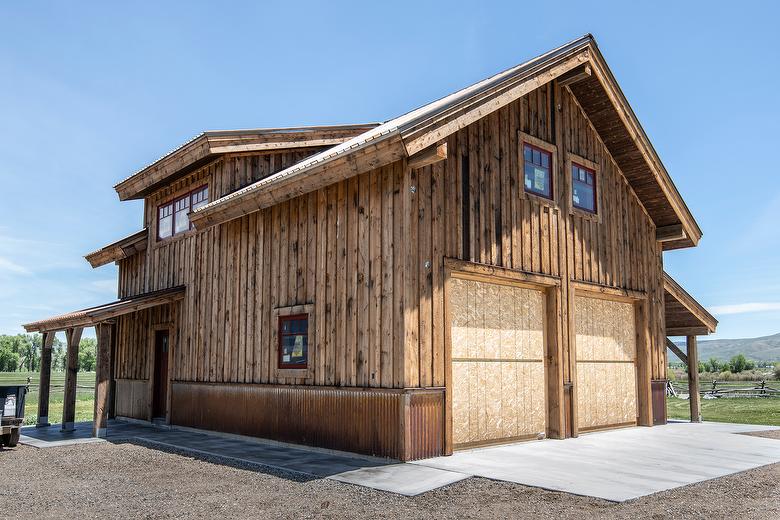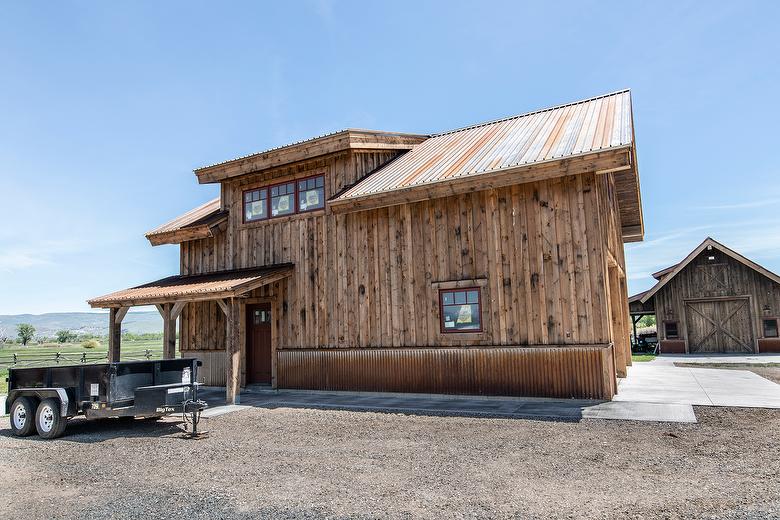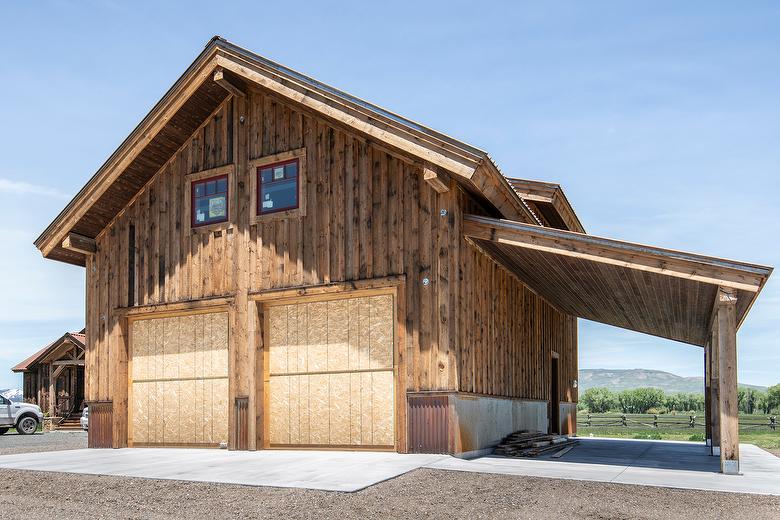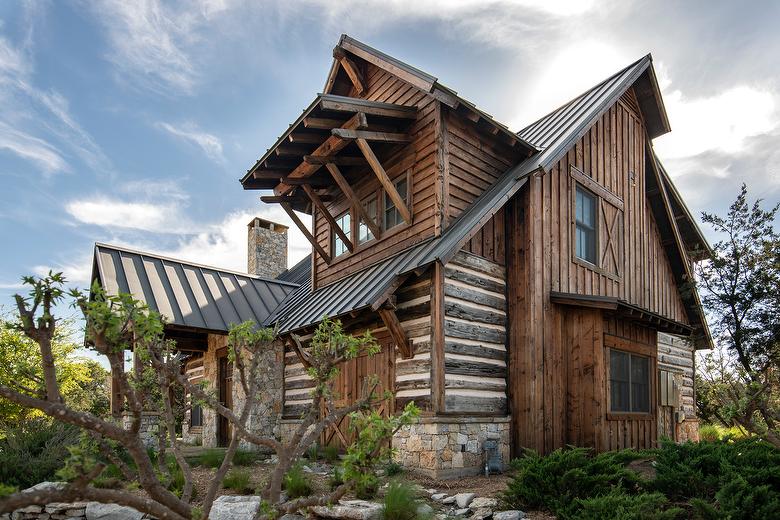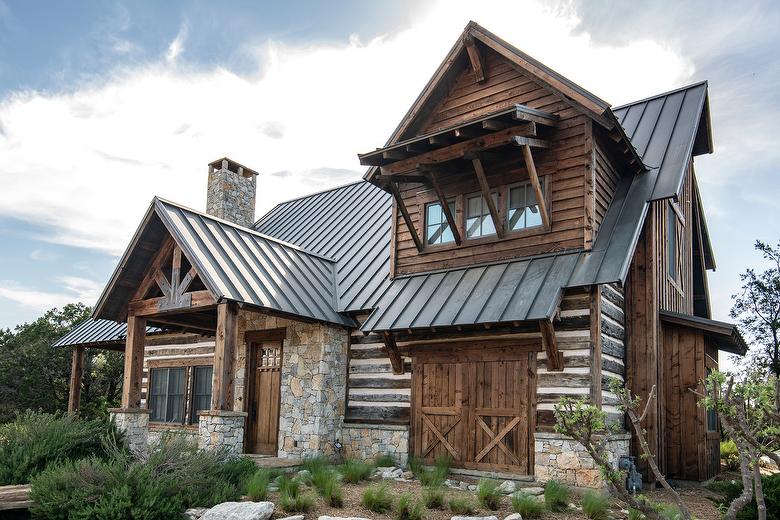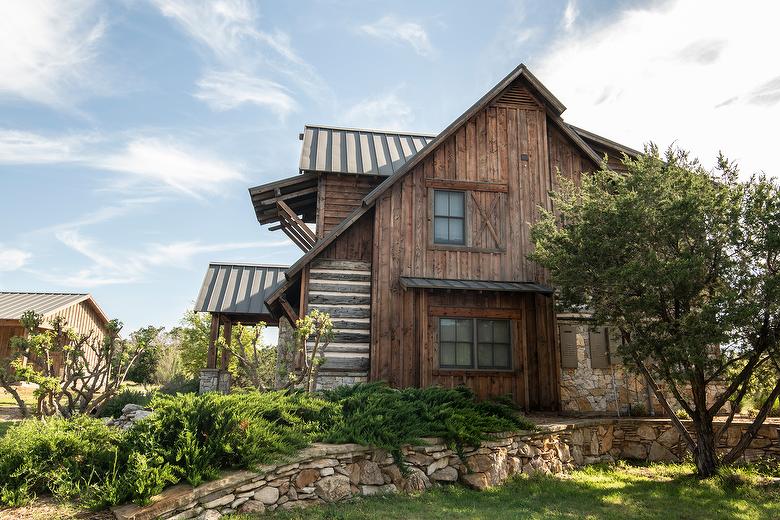HarborAged Brown Siding
HarborAged Brown Siding
Board-and-Bat
Specification Sheet# 2240 - HarborAged Brown Lumber
Request Quote
Height
Width
Length
Quantity
1"
8-12" boards w/ 4" bats
Rand 4-12'
min: 250 sf
Related Productline Pages
HarborAged Brown Siding
Specification Sheet #2240 - HarborAged Brown Lumber
Species
Often, but not always, Douglas Fir and/or other Firs
Source
HarborAged Brown timbers and lumber can be produced from a variety of sources, including i) new timbers/lumber (most common); ii) timbers/lumber cut from beetle-killed, fire-killed or dead-standing trees; iii) timbers/lumber cut from material which has weathered out of spec; and/or iv) timbers/lumber reclaimed from various salvage projects. HarborAged Brown timbers and lumber are typically sprayed with water from the Great Salt Lake or with water which produces a similar effect, often when in contact with metal, to introduce dark staining/streaking and other character.
Metal
Metal is often used in combination with salt water to add character to HarborAged Brown timbers and lumber. Most HarborAged Brown timbers and lumber do not have metal in them.
Holes
HarborAged Brown Lumber will generally have nail holes where lumber has been attached to pallets. HarborAged Brown timbers can have (but often do not have) nail holes and/or bolt holes. Where there are holes, there will often be staining and/or streaking around the holes.
Checking/Cracks
Timbers generally have checks from the heart center to the faces of the timber. In addition, timbers can have surface checking and cracks, moderate butt checking and minor end splitting. Lumber can have surface checking and cracks and minor end splitting.
Moisture Content/Stability
The moisture content of HarborAged Brown timbers and lumber can vary from Green to Air-Dried. HarborAged Brown timbers and lumber should not be considered as stable as reclaimed timbers and lumber.
Standard Dimensions
a) Height: 1" (actual typically 5/8" to 1") and 2" (actual typically 1 1/2" to 2"); b) Width: to 12" (actual typically up to 7/8" nominal); c) Lengths: to 16' (some longer lengths are sometimes available upon request.) All dimensions/lengths mentioned are for unmilled lumber. As timbers and lumber air dry (or are kiln dried), they tend to shrink somewhat, resulting in dimensions becoming somewhat more nominal.
Weight
Typically, 3 to 3.5 pounds per board foot.
Surfacing
Rough-Sawn (Circle-Sawn and/or Band-Sawn.) HarborAged Brown timbers and lumber can also be Planed, but such further processing can take off much of the coloring / aged appearance introduced by the HarborAged process.
Salt/Minerals
HarborAged Brown timbers and lumber can contain some salt and other minerals from being sprayed with water from the Great Salt Lake. While these timbers and lumber do not have near the salt/mineral content of Trestlewood II (Salty Fir) timbers and lumber, one should be aware of potential special characteristics/considerations such as: Finishes/Glues (be careful with water-based products); Metal Corrosiveness (use high-grade stainless steel fasteners if the objective is to minimize corrosion); Moisture; Odor; and Salt Leaching. See Trestlewood II specification sheets and other product documentation for further information.
Color/Appearance
HarborAged Brown timbers and lumber are generally sprayed with water from the Great Salt Lake. The interaction between the wood fiber and the minerals in the water produce unique colors in the material. The interaction of the minerals in the water and the metal brought into contact with the timbers and lumber can also impact material coloration by creating staining and/or streaking around holes and/or other metal contact points. We believe that the net effect is a visually appealing, aged appearance. The coloring and aging are generally more pronounced on the surface of this material and do not extend deeply into the material (they may be "processed off", at least in part, if the material is band-sawn, planed or otherwise processed after soaking/spraying.) We believe that band-sawn or planed HarborAged Brown timbers and lumber usually retain at least some benefit from the soaking/spraying process such as staining/streaking around bolt/nail holes and some wood discoloration.
Appearance Variation
Boards can vary in appearance from piece to piece and even within a piece. The characteristics described on this specification sheet generally apply to each board's featured face. The opposite face and edges can differ from the featured face in texture, coloring, and other characteristics unless otherwise noted.
Siding Product Configurations
When Trestlewood quotes 1,000 square feet of a specific siding configuration, it is quoting enough material to provide 1,000 square feet of coverage based on default installation assumptions and 0% installation falldown. Buyer should order enough product to cover anticipated installation falldown and the impact of any changes to installation assumptions. Siding configuration options include:
(a) Board to Board (common widths: 4", 6", 8", 10", mixed)
(b) Board and Batten (common board widths: 8", 10", 12"; typical batten width: 4"; assumed: installed with 2" gaps between boards)
(c) Board on Board (common widths: 6", 8", 10", mixed; assumed: installed with 1" overlap on each edge)
(d) Shiplap (standard face widths: 4.625", 6.375", 8.375"; target thickness: 0.72" (23/32") (a weathered face shiplap product will naturally have some thickness variation); most commonly, 3/8" shiplap joints are milled on opposite edges and opposite sides of boards)
(e) Wedgelap w/ Rabbet (common face widths: 5" to 5 1/4" (typical actual coverage of 4 1/2" to 4 3/4"), 7" to 7 1/4" (6 1/2" to 6 3/4"), 9" to 9 1/4" (8 1/2" to 8 3/4"); typical thickness of +/- 1/4" on thin side to 3/4" or a bit less on thick side; rabbet added to thick side); stress reliefs are NOT added to the back face; this is a custom product and cannot be returned
(f) Wedgelap w/o Rabbet - this product is typically cut on a resaw and is not as exact (i.e., there will be more variation in dimensions) as Wedgelap with Rabbet. Involves cutting a wedge in as-is lumber (usually 6", 8", or 10" nominal width.) Resulting product will generally have thickness of 1/4"+ to 11/16-7/8" and width of 5.25"+, 7.25"+, or 9.25"+ (with coverage width depending on how installed on site (often 4.5"+/-, 6.5"+/-, 8.5"+/-.) Stress reliefs are NOT added to the back face. Lumber is NOT double end trimmed. The wedgelap without rabbet does not sit as flat on the wall as the wedgelap with rabbet - this likely increases the chances of cupping, splitting, and/or other movement over time. This is a custom product and cannot be returned.
(g) T&G (standard face widths: 3", 4.75", 6.5", 8.5";standard target thickness: 0.72" (23/32") (a weathered face T&G product will naturally have some thickness variation); the fit of barnwood siding T&G is often not quite as good as flooring T&G)
Unmilled siding products (a, b, and c) are standard barnwood lumber. The milling process generally reduces but does not eliminate variation in actual thicknesses and widths (across boards and even within specific boards.) The milling process often creates additional character like loose or fallen out knots. Such defects are generally left in the boards; buyer can decide whether to install them as is, cut them out, or fill them. Kiln drying lumber prior to milling it can increase the tendency for knots to become loose during the milling process. The average length of siding boards (especially milled siding boards) will generally be less (sometimes significantly less) than the average length of lumber boards.
Trestlewood makes no representations about the fitness of its products for use as siding or in any other application. It is ultimately the Buyer's responsibility to (a) determine which products (and their accompanying characteristics) are acceptable for use on its project and then to (b) make sure these products are handled and installed correctly. While Trestlewood is not a construction or installation expert, it does periodically pass on (without any guarantee of accuracy) information/resources to its customers that it thinks might provide helpful starting points to consider - see, for example, Trestlewood's 7/14/2023 blog post "Exterior Wood Siding Thoughts to Consider" and Document #240173 referenced therein.)
(a) Board to Board (common widths: 4", 6", 8", 10", mixed)
(b) Board and Batten (common board widths: 8", 10", 12"; typical batten width: 4"; assumed: installed with 2" gaps between boards)
(c) Board on Board (common widths: 6", 8", 10", mixed; assumed: installed with 1" overlap on each edge)
(d) Shiplap (standard face widths: 4.625", 6.375", 8.375"; target thickness: 0.72" (23/32") (a weathered face shiplap product will naturally have some thickness variation); most commonly, 3/8" shiplap joints are milled on opposite edges and opposite sides of boards)
(e) Wedgelap w/ Rabbet (common face widths: 5" to 5 1/4" (typical actual coverage of 4 1/2" to 4 3/4"), 7" to 7 1/4" (6 1/2" to 6 3/4"), 9" to 9 1/4" (8 1/2" to 8 3/4"); typical thickness of +/- 1/4" on thin side to 3/4" or a bit less on thick side; rabbet added to thick side); stress reliefs are NOT added to the back face; this is a custom product and cannot be returned
(f) Wedgelap w/o Rabbet - this product is typically cut on a resaw and is not as exact (i.e., there will be more variation in dimensions) as Wedgelap with Rabbet. Involves cutting a wedge in as-is lumber (usually 6", 8", or 10" nominal width.) Resulting product will generally have thickness of 1/4"+ to 11/16-7/8" and width of 5.25"+, 7.25"+, or 9.25"+ (with coverage width depending on how installed on site (often 4.5"+/-, 6.5"+/-, 8.5"+/-.) Stress reliefs are NOT added to the back face. Lumber is NOT double end trimmed. The wedgelap without rabbet does not sit as flat on the wall as the wedgelap with rabbet - this likely increases the chances of cupping, splitting, and/or other movement over time. This is a custom product and cannot be returned.
(g) T&G (standard face widths: 3", 4.75", 6.5", 8.5";standard target thickness: 0.72" (23/32") (a weathered face T&G product will naturally have some thickness variation); the fit of barnwood siding T&G is often not quite as good as flooring T&G)
Unmilled siding products (a, b, and c) are standard barnwood lumber. The milling process generally reduces but does not eliminate variation in actual thicknesses and widths (across boards and even within specific boards.) The milling process often creates additional character like loose or fallen out knots. Such defects are generally left in the boards; buyer can decide whether to install them as is, cut them out, or fill them. Kiln drying lumber prior to milling it can increase the tendency for knots to become loose during the milling process. The average length of siding boards (especially milled siding boards) will generally be less (sometimes significantly less) than the average length of lumber boards.
Trestlewood makes no representations about the fitness of its products for use as siding or in any other application. It is ultimately the Buyer's responsibility to (a) determine which products (and their accompanying characteristics) are acceptable for use on its project and then to (b) make sure these products are handled and installed correctly. While Trestlewood is not a construction or installation expert, it does periodically pass on (without any guarantee of accuracy) information/resources to its customers that it thinks might provide helpful starting points to consider - see, for example, Trestlewood's 7/14/2023 blog post "Exterior Wood Siding Thoughts to Consider" and Document #240173 referenced therein.)
Processing Options
Additional processing options often available include kiln drying, fumigation, thickness planing/resawing (to reduce thickness variation), edging (to reduce width variation), pressure washing, and metal removal / metal detecting (does not result in guarantee that all metal is removed.) Many of these processing steps are likely to increase the number of loose and open knots.
Other
HarborAged Brown timbers and lumber can have some (a) punkiness around their edges and (b) wane.







